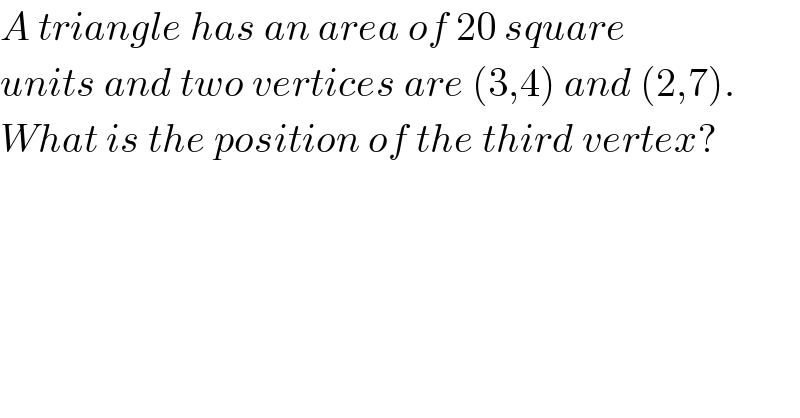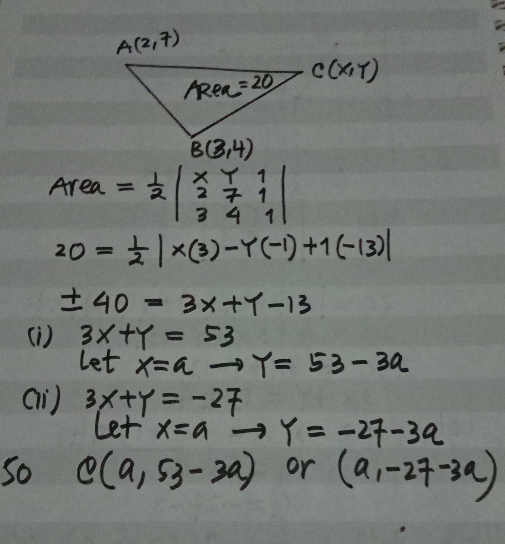
Question Number 76252 by necxxx last updated on 25/Dec/19

$${A}\:{triangle}\:{has}\:{an}\:{area}\:{of}\:\mathrm{20}\:{square} \\ $$$${units}\:{and}\:{two}\:{vertices}\:{are}\:\left(\mathrm{3},\mathrm{4}\right)\:{and}\:\left(\mathrm{2},\mathrm{7}\right). \\ $$$${What}\:{is}\:{the}\:{position}\:{of}\:{the}\:{third}\:{vertex}? \\ $$
Commented by MJS last updated on 25/Dec/19

$$\mathrm{in}\:\mathrm{words}:\:\mathrm{we}\:\mathrm{know}\:\mathrm{the}\:\mathrm{area}=\frac{\mathrm{side}×\mathrm{height}}{\mathrm{2}} \\ $$$$\mathrm{and}\:\mathrm{we}\:\mathrm{know}\:\mathrm{the}\:\mathrm{side}=\sqrt{\left(\mathrm{3}−\mathrm{2}\right)^{\mathrm{2}} +\left(\mathrm{4}−\mathrm{7}\right)^{\mathrm{2}} }= \\ $$$$=\sqrt{\mathrm{10}}\:\Rightarrow\:\mathrm{height}=\frac{\mathrm{2}×\mathrm{area}}{\mathrm{side}}=\frac{\mathrm{40}}{\sqrt{\mathrm{10}}}=\mathrm{4}\sqrt{\mathrm{10}} \\ $$$$\mathrm{all}\:\mathrm{triangles}\:\mathrm{with}\:{s}=\sqrt{\mathrm{10}}\wedge{h}=\mathrm{4}\sqrt{\mathrm{10}}\:\mathrm{have}\:\mathrm{the} \\ $$$$\mathrm{same}\:\mathrm{area}\:\Rightarrow\:\mathrm{3}^{\mathrm{rd}} \:\mathrm{vertex}\:\mathrm{is}\:\mathrm{located}\:\mathrm{on}\:\mathrm{two} \\ $$$$\mathrm{lines}\:\mathrm{parallel}\:\mathrm{to}\:\mathrm{the}\:\mathrm{line}\:\mathrm{through}\:\mathrm{the}\:\mathrm{given} \\ $$$$\mathrm{vertices}\:\mathrm{and}\:\mathrm{with}\:\mathrm{distance}\:\mathrm{4}\sqrt{\mathrm{10}}\:\mathrm{from}\:\mathrm{this}\:\mathrm{line} \\ $$$$\mathrm{let}\:{A}=\begin{pmatrix}{\mathrm{3}}\\{\mathrm{4}}\end{pmatrix}\:\:{B}=\begin{pmatrix}{\mathrm{2}}\\{\mathrm{7}}\end{pmatrix} \\ $$$$\mathrm{the}\:\mathrm{distance}\:\mathrm{of}\:\mathrm{two}\:\mathrm{parallel}\:\mathrm{lines} \\ $$$${y}={a}_{\mathrm{0}} {x}+{b}_{\mathrm{0}} ,\:{y}={a}_{\mathrm{0}} {x}+{b}_{\mathrm{1}} \\ $$$$\mathrm{is}\:{d}=\frac{\mid{b}_{\mathrm{1}} −{b}_{\mathrm{0}} \mid}{\sqrt{{a}^{\mathrm{2}} +\mathrm{1}}}\:\Leftrightarrow\:{b}_{\mathrm{1}} ={b}_{\mathrm{0}} \pm{d}\sqrt{{a}^{\mathrm{2}} +\mathrm{1}} \\ $$$$\Rightarrow \\ $$$$\mathrm{line}\:{AB}:\:{y}=\mathrm{13}−\mathrm{3}{x} \\ $$$$\mathrm{line}\:{C}_{\mathrm{1}} :\:{y}=−\mathrm{27}−\mathrm{3}{x} \\ $$$$\mathrm{line}\:{C}_{\mathrm{2}} :\:{y}=\mathrm{53}−\mathrm{3}{x} \\ $$$$\Rightarrow \\ $$$${C}=\begin{pmatrix}{{x}}\\{−\mathrm{27}−\mathrm{3}{x}}\end{pmatrix}\vee{C}=\begin{pmatrix}{{x}}\\{\mathrm{53}−\mathrm{3}{x}}\end{pmatrix} \\ $$
Answered by benjo last updated on 25/Dec/19

Commented by necxxx last updated on 30/Dec/19

$${thank}\:{you}\:{so}\:{much}.\:{I}'{m}\:{most}\:{grateful}. \\ $$
